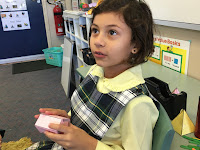As we begin to use the key design thinking steps a little more in our lessons, we find that we can focus on one smaller part at a time, making the task better managed and improving our progress.
We have been learning about playgrounds, their purpose, the reason for the various types of equipment and the forces required in the course of using each one.
So far, we have been able to:
DISCOVER: by exploring the location, look and purpose of a variety of playgrounds.
DEFINE - Our goal and direction - to create a playground for a specific age group considering exercise, aesthetics and safety.
DREAM - spent much time thinking of possibilities - really digging into our imagination and thinking of ideas
On Thursday this week, we will begin to build our models and see how well they meet the criteria. Early next week, we will then evaluate the models and improve them.
We have spent some time visiting the agriculture plot and thinking about how we can use the activities that go on there to help us in different aspects of our learning. We are still in the very early stages and will keep you informed.
 |
| Thanks for your hard work Rihanna and Lachlan |





























